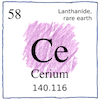Berlin, Bastnäs, Stockholm—Martin Heinrich Klaproth,
Jöns Jacob Berzelius,
Wilhelm Hisinger,
Carl Gustaf Mosander
elements

|
Cerium
Klaproth and the team of Berzelius and Hisinger discovered the new earth from the Bastnäs mine. Klaproth called it ochroite because if its ochre color, but the honor of naming it went to Berzelius and Hisinger and they called it cerium after the dwarf planet Ceres, which Piazzi had named after goddess of golden grain. “Hold it a second,” said Klaproth. “If you name it after Ceres, it should be cererium.” Nevertheless, Mosander later isolated pure cerium and showed that the cerium oxide previously discovered contained other rare earths. Eventually, the oxide produced not only cerium, but also lanthanum, gadolinium, praseodymium, neodymium, samarium, and europium.
Atomic number 58
Ferrocerium alloy is pyrophoric. Look for that in your cigarette-lighter flints. Carl Auer von Welsbach invented the flints as a use for cerium, as well as successful gas mantles. Mischmetal, a mix of cerium and rare earths, is used in aluminum and iron alloys. Cerium spontaneously ignites in air and its hot gases are toxic.
Stuff with sparks
Different ferrous metals when applied to a grinding wheel produce different patterns of sparks. When a flint strikes a steel the sparks that fly are fragments of burning steel but sparks that fly from a ferrocerium flint are fragments of burning cerium.



Wilhelm Hisinger was the first to observe that during electrolysis an element migrates to either the cathode (negative) or the anode (positive). Cerium is electropositive; it migrates to the anode.
See also in The book of science:
Readings in wikipedia:
Other readings: